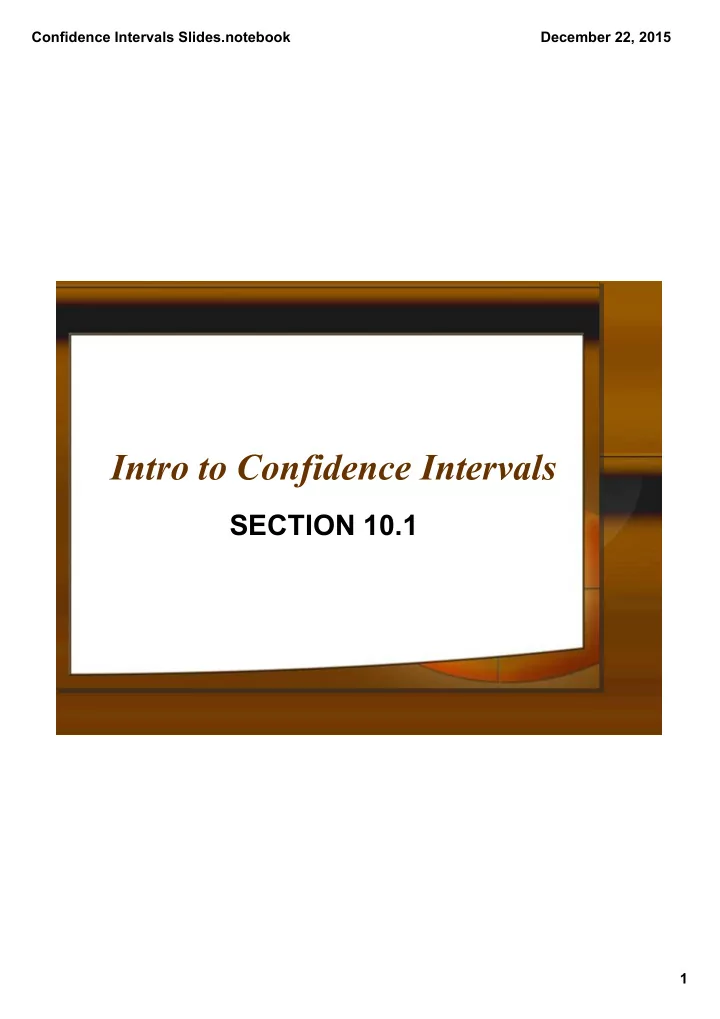

Confidence Intervals Slides.notebook December 22, 2015 Intro to Confidence Intervals SECTION 10.1 1
Confidence Intervals Slides.notebook December 22, 2015 Definitions • Statistical Inference: • estimate of the characteristics of a population • derived from the analysis of a sample drawn from the population • provides methods of drawing conclusions about a population from sample data • population: everyone • parameter: a number from a population • Symbols • sample: a part of the population • statistic: a number from a sample • Symbols 2
Confidence Intervals Slides.notebook December 22, 2015 NOTE TO SELF The Central Limit theorem plays an important role in statistical inference. 2 types of statistical inference: Confidence intervals (10.1) Tests of significance (10.2) 3
Confidence Intervals Slides.notebook December 22, 2015 • You want to estimate the mean SAT Math score for the more than 350,000 high school seniors in California. • You give the test to a simple random sample (SRS) of 500 CA seniors. • RECALL: • The central limit theorem tells us that the mean, x, of 500 scores has a distribution that is close to normal. 4
Confidence Intervals Slides.notebook December 22, 2015 • The mean of this normal sampling distribution is the same as the unknown mean, , of the entire population. • The standard deviation of x for an SRS of 500 students is , where is the standard deviation of individual SAT MATH scores among all CA high school seniors. 5
Confidence Intervals Slides.notebook December 22, 2015 Statistical Confidence • The 689599.7 rule says that in 95% of all samples, the mean score x for the sample will be within 2 standard deviations (9 points in this example) of the population mean score • Therefore, in 95% of all samples, the unknown lies between x – 9 and x + 9. 6
Confidence Intervals Slides.notebook December 22, 2015 Confidence Interval has the form: estimate + margin of error Estimate: guess for unknown parameter (usually μ) We will use X here MOE: how accurate we believe guess is based on variability of estimate 7
Confidence Intervals Slides.notebook December 22, 2015 Confidence Level, C Gives probability that the interval will capture true population mean, μ, in repeated samples “C” will be expressed in decimal form Note: we generally want a confidence level of .9 or 90% or higher 8
Confidence Intervals Slides.notebook December 22, 2015 • This shows the result of drawing 25 SRSs from the same population and calculating a 95% confidence interval from each sample. • The center x of each interval is marked by a dot. • The arrows on either side of the dot span the confidence interval. • CONCLUSION: 95% of all samples give an interval that contains the population mean . 9
Confidence Intervals Slides.notebook December 22, 2015 Formula for Confidence Interval Choose an SRS of size n from a population having unknown mean μ and known standard deviation σ. A level C confidence interval for μ is estimate + margin of error • Everything will be given in the problem except z* • z* depends on the confidence level you choose • z* is the value with area C between –z* and z* under the standard normal curve. 10
Confidence Intervals Slides.notebook December 22, 2015 Most common confidence levels: C Tail Area z* 90% 0.05 1.645 95% 0.025 1.960 99% 0.005 2.576 Calculator can find z* values: 11
Confidence Intervals Slides.notebook December 22, 2015 What does 95% confidence mean? • We are 95% confident that the true population mean is captured in the interval OR • We are using a procedure that captures the true population mean 95% of the time. 12
Confidence Intervals Slides.notebook December 22, 2015 Example 1 I sample 30 cats. X = 6 lbs. I know that σ = 3 lbs. • a) Find a 90% CI. • b) Find a 95% CI. • c) Find a 99% CI. **Express what these confidence intervals indicate in terms of the problem.** e) Explain why the intervals get wider as your confidence level increases. 13
Confidence Intervals Slides.notebook December 22, 2015 CALCULATOR!!!! • STAT • TEST • ZINTERVAL (#7) • STATS • Plug info in and calculate. • Show 14
Confidence Intervals Slides.notebook December 22, 2015 Example 2 Heights are normally distributed. I measure the heights of 25 randomly selected students. The average is 66 inches. I know that the population S.D. (σ) is 4 inches. • a) Find a 90% CI. • b) Find a 95% CI. • c) Find a 97% CI. • d) Find a 99.9% CI 15
Confidence Intervals Slides.notebook December 22, 2015 Example 3 SAT verbal scores are normally distributed with σ = 50. 25 students are selected randomly and their average score is 492. • a) Find a 99% Confidence Interval. • If 100 students are selected and their average is still 492, find the new 99% Confidence Interval. 16
Confidence Intervals Slides.notebook December 22, 2015 Example 4 The following 10 bunny weights are collected. 7 8 9 8.5 10 11 8.5 9.5 10.5 10 Find a 90% confidence interval for bunny weights based on this sample! Assume σ = 1.5. 17
Confidence Intervals Slides.notebook December 22, 2015 In Summary Increasing my confidence level will _________________ my margin of error, and therefore also ____________ my interval width. Increasing my sample size will _______________ my margin of error. If we want to cut our M.O.E. in half, what should we do to our sample size? 18
Confidence Intervals Slides.notebook December 22, 2015 19
Recommend
More recommend